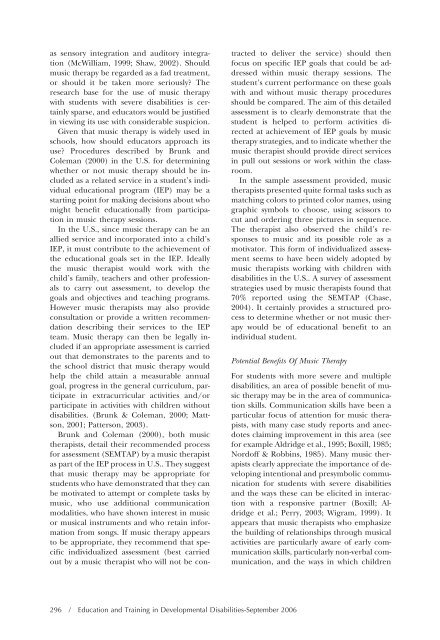Music Therapy and the Education of Students with Severe Disabilities
Music Therapy and the Education of Students with Severe Disabilities
Music Therapy and the Education of Students with Severe Disabilities
You also want an ePaper? Increase the reach of your titles
YUMPU automatically turns print PDFs into web optimized ePapers that Google loves.
as sensory integration <strong>and</strong> auditory integration<br />
(McWilliam, 1999; Shaw, 2002). Should<br />
music <strong>the</strong>rapy be regarded as a fad treatment,<br />
or should it be taken more seriously? The<br />
research base for <strong>the</strong> use <strong>of</strong> music <strong>the</strong>rapy<br />
<strong>with</strong> students <strong>with</strong> severe disabilities is certainly<br />
sparse, <strong>and</strong> educators would be justified<br />
in viewing its use <strong>with</strong> considerable suspicion.<br />
Given that music <strong>the</strong>rapy is widely used in<br />
schools, how should educators approach its<br />
use? Procedures described by Brunk <strong>and</strong><br />
Coleman (2000) in <strong>the</strong> U.S. for determining<br />
whe<strong>the</strong>r or not music <strong>the</strong>rapy should be included<br />
as a related service in a student’s individual<br />
educational program (IEP) may be a<br />
starting point for making decisions about who<br />
might benefit educationally from participation<br />
in music <strong>the</strong>rapy sessions.<br />
In <strong>the</strong> U.S., since music <strong>the</strong>rapy can be an<br />
allied service <strong>and</strong> incorporated into a child’s<br />
IEP, it must contribute to <strong>the</strong> achievement <strong>of</strong><br />
<strong>the</strong> educational goals set in <strong>the</strong> IEP. Ideally<br />
<strong>the</strong> music <strong>the</strong>rapist would work <strong>with</strong> <strong>the</strong><br />
child’s family, teachers <strong>and</strong> o<strong>the</strong>r pr<strong>of</strong>essionals<br />
to carry out assessment, to develop <strong>the</strong><br />
goals <strong>and</strong> objectives <strong>and</strong> teaching programs.<br />
However music <strong>the</strong>rapists may also provide<br />
consultation or provide a written recommendation<br />
describing <strong>the</strong>ir services to <strong>the</strong> IEP<br />
team. <strong>Music</strong> <strong>the</strong>rapy can <strong>the</strong>n be legally included<br />
if an appropriate assessment is carried<br />
out that demonstrates to <strong>the</strong> parents <strong>and</strong> to<br />
<strong>the</strong> school district that music <strong>the</strong>rapy would<br />
help <strong>the</strong> child attain a measurable annual<br />
goal, progress in <strong>the</strong> general curriculum, participate<br />
in extracurricular activities <strong>and</strong>/or<br />
participate in activities <strong>with</strong> children <strong>with</strong>out<br />
disabilities. (Brunk & Coleman, 2000; Mattson,<br />
2001; Patterson, 2003).<br />
Brunk <strong>and</strong> Coleman (2000), both music<br />
<strong>the</strong>rapists, detail <strong>the</strong>ir recommended process<br />
for assessment (SEMTAP) by a music <strong>the</strong>rapist<br />
as part <strong>of</strong> <strong>the</strong> IEP process in U.S.. They suggest<br />
that music <strong>the</strong>rapy may be appropriate for<br />
students who have demonstrated that <strong>the</strong>y can<br />
be motivated to attempt or complete tasks by<br />
music, who use additional communication<br />
modalities, who have shown interest in music<br />
or musical instruments <strong>and</strong> who retain information<br />
from songs. If music <strong>the</strong>rapy appears<br />
to be appropriate, <strong>the</strong>y recommend that specific<br />
individualized assessment (best carried<br />
out by a music <strong>the</strong>rapist who will not be con-<br />
tracted to deliver <strong>the</strong> service) should <strong>the</strong>n<br />
focus on specific IEP goals that could be addressed<br />
<strong>with</strong>in music <strong>the</strong>rapy sessions. The<br />
student’s current performance on <strong>the</strong>se goals<br />
<strong>with</strong> <strong>and</strong> <strong>with</strong>out music <strong>the</strong>rapy procedures<br />
should be compared. The aim <strong>of</strong> this detailed<br />
assessment is to clearly demonstrate that <strong>the</strong><br />
student is helped to perform activities directed<br />
at achievement <strong>of</strong> IEP goals by music<br />
<strong>the</strong>rapy strategies, <strong>and</strong> to indicate whe<strong>the</strong>r <strong>the</strong><br />
music <strong>the</strong>rapist should provide direct services<br />
in pull out sessions or work <strong>with</strong>in <strong>the</strong> classroom.<br />
In <strong>the</strong> sample assessment provided, music<br />
<strong>the</strong>rapists presented quite formal tasks such as<br />
matching colors to printed color names, using<br />
graphic symbols to choose, using scissors to<br />
cut <strong>and</strong> ordering three pictures in sequence.<br />
The <strong>the</strong>rapist also observed <strong>the</strong> child’s responses<br />
to music <strong>and</strong> its possible role as a<br />
motivator. This form <strong>of</strong> individualized assessment<br />
seems to have been widely adopted by<br />
music <strong>the</strong>rapists working <strong>with</strong> children <strong>with</strong><br />
disabilities in <strong>the</strong> U.S.. A survey <strong>of</strong> assessment<br />
strategies used by music <strong>the</strong>rapists found that<br />
70% reported using <strong>the</strong> SEMTAP (Chase,<br />
2004). It certainly provides a structured process<br />
to determine whe<strong>the</strong>r or not music <strong>the</strong>rapy<br />
would be <strong>of</strong> educational benefit to an<br />
individual student.<br />
Potential Benefits Of <strong>Music</strong> <strong>Therapy</strong><br />
296 / <strong>Education</strong> <strong>and</strong> Training in Developmental <strong>Disabilities</strong>-September 2006<br />
For students <strong>with</strong> more severe <strong>and</strong> multiple<br />
disabilities, an area <strong>of</strong> possible benefit <strong>of</strong> music<br />
<strong>the</strong>rapy may be in <strong>the</strong> area <strong>of</strong> communication<br />
skills. Communication skills have been a<br />
particular focus <strong>of</strong> attention for music <strong>the</strong>rapists,<br />
<strong>with</strong> many case study reports <strong>and</strong> anecdotes<br />
claiming improvement in this area (see<br />
for example Aldridge et al., 1995; Boxill, 1985;<br />
Nord<strong>of</strong>f & Robbins, 1985). Many music <strong>the</strong>rapists<br />
clearly appreciate <strong>the</strong> importance <strong>of</strong> developing<br />
intentional <strong>and</strong> presymbolic communication<br />
for students <strong>with</strong> severe disabilities<br />
<strong>and</strong> <strong>the</strong> ways <strong>the</strong>se can be elicited in interaction<br />
<strong>with</strong> a responsive partner (Boxill; Aldridge<br />
et al.; Perry, 2003; Wigram, 1999). It<br />
appears that music <strong>the</strong>rapists who emphasize<br />
<strong>the</strong> building <strong>of</strong> relationships through musical<br />
activities are particularly aware <strong>of</strong> early communication<br />
skills, particularly non-verbal communication,<br />
<strong>and</strong> <strong>the</strong> ways in which children
















